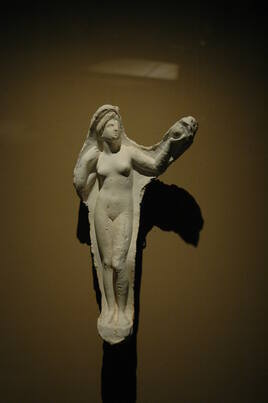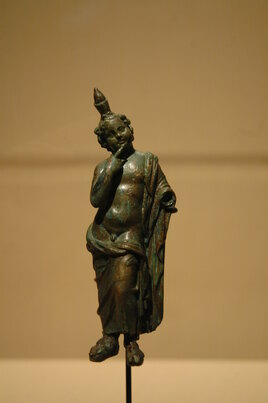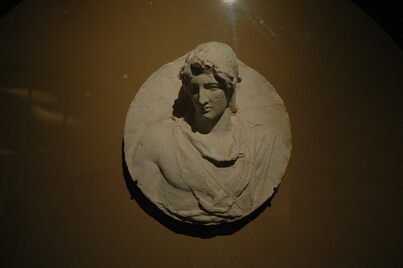Es gibt noch keine deutschsprachige Anmerkungen. Präsentiert wirden Anmerkungen auf Niederländisch.
A very large Kushan-era urban site overlooking the river, consisting of a long fortified area made up of two walled enclosures: the Burj-i Abdullah to the north and the "new royal city" to the south, where most of the excavations have taken place. There is in addition a third, purely urban area farther south.
During the 19th century Begram was the site of extensive coin collecting, with a full range from Mauryan through to Ghurid being recovered.
Between 1937 and 1946, the Delegation Archaeologique Francaise Afghanistan (DAFA), in three periods of excavation, uncovered parts of the entrance to the city, the Kushan summer palace, the fortifications, and the bazaar — including two rooms (Nos. 10 and 13) in the palace, which were discovered intact and contained a vast treasure:
• the fabled Begram Ivories from India,
• molded stucco ornaments of Greek origin,
• glassware from Syria and Egypt,
• bronzes from Rome and Egypt,
• lacquer objects from China
and many objects of local manufacture, dating from the 1st century BC to the beginning of the 3rd century AD. These fruits of the Silk Road trade demonstrate the cosmopolitan culture and considerable wealth that existed in Afghanistan during the Kushan era. Since Begram was conquered and sacked by the Sassanians during the 2nd quarter of the third century A.D., it's likely that rooms No. 10 and 13 in the palace had been sealed up prior to the invasion. The Begram treasure was found scattered about these two rooms in a way that suggests the objects were too numerous for the fleeing Kushans to take with them. So they were simply left behind.
Source: Warwick Ball, Archaeological Gazetteer of Afghanistan, 1982, n. 73
Alexandria in the Caucasus: town founded by Alexander the Great, modern Charikar near Begram, north of Kabul in Afghanistan. See http://www.livius.org/aj-al/alexandria/alexandria_caucasus.html
https://en.wikipedia.org/wiki/Bagram
BALL Warwick (2018), Archaeological gazetteer of Afghanistan, revised edition, Oxford
A very large Kushan-era urban site overlooking the river, consisting of a long fortified area made up of two walled enclosures: the Burj-i Abdullah to the north and the "new royal city" to the south, where most of the excavations have taken place. There is in addition a third, purely urban area farther south.
During the 19th century Begram was the site of extensive coin collecting, with a full range from Mauryan through to Ghurid being recovered.
Between 1937 and 1946, the Delegation Archaeologique Francaise Afghanistan (DAFA), in three periods of excavation, uncovered parts of the entrance to the city, the Kushan summer palace, the fortifications, and the bazaar — including two rooms (Nos. 10 and 13) in the palace, which were discovered intact and contained a vast treasure:
• the fabled Begram Ivories from India,
• molded stucco ornaments of Greek origin,
• glassware from Syria and Egypt,
• bronzes from Rome and Egypt,
• lacquer objects from China
and many objects of local manufacture, dating from the 1st century BC to the beginning of the 3rd century AD. These fruits of the Silk Road trade demonstrate the cosmopolitan culture and considerable wealth that existed in Afghanistan during the Kushan era. Since Begram was conquered and sacked by the Sassanians during the 2nd quarter of the third century A.D., it's likely that rooms No. 10 and 13 in the palace had been sealed up prior to the invasion. The Begram treasure was found scattered about these two rooms in a way that suggests the objects were too numerous for the fleeing Kushans to take with them. So they were simply left behind.
Source: Warwick Ball, Archaeological Gazetteer of Afghanistan, 1982, n. 73




